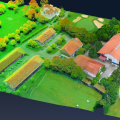
The US Defense Department has agreed to install surveillance radar in Australia capable of identifying objects in low-earth orbit and an advanced space telescope capable of eyeballing objects 35,000 km in space. The agreement follows recent high-level talks between the two countries.
The joint communique agreed to by Defense Secretary Leon Panetta, Secretary of State Hillary Clinton, Australian Foreign Minister Bob Carr and Defense Minister Stephen Smith also looked at developing a combined communications gateway in Western Australia that the Pentagon’s Wideband Global Satellite System could access.
Australia invested USD 740.9 million in the Wideband Global Satellite System in 2007, which eventually will consist of nine satellites in a geosynchronous orbit. Each satellite has a maximum data rate of 3.6 gigabits per second of data.
At a news conference in Perth after the meeting, Panetta said the space agreement “represents a major leap forward in bilateral space cooperation and an important new frontier in the United States' rebalance to the Asia-Pacific region.” President Obama called for increased Pentagon focus on the Asia-Pacific region in a 21st century military strategy released in January.
The C-band ground surveillance radar the Pentagon plans to move to Australia currently is located in Antigua and operates as part of a global space surveillance network to detect, track and identify objects in space. Moving the radar to Australia will provide, for the first time, coverage of space objects in the Southern and Eastern hemispheres and track space launches in Asia, the Pentagon said.
Relocating the C-band radar to Australia and putting it into operation will cost about USD 30 million and an additional USD 8 million to USD 10 million a year to operate. A senior US Defense official said the United States then will train Australians to operate the system.
The agreement also covers installation of the advanced Space Surveillance Telescope the Defense Advanced Research Projects Agency developed and first demonstrated in 2011. The Pentagon said this telescope can detect and track microsatellites, space and other objects at “deep space altitudes” — approx. 35,000 km, or the geosynchronous orbit used by most communications satellites.







